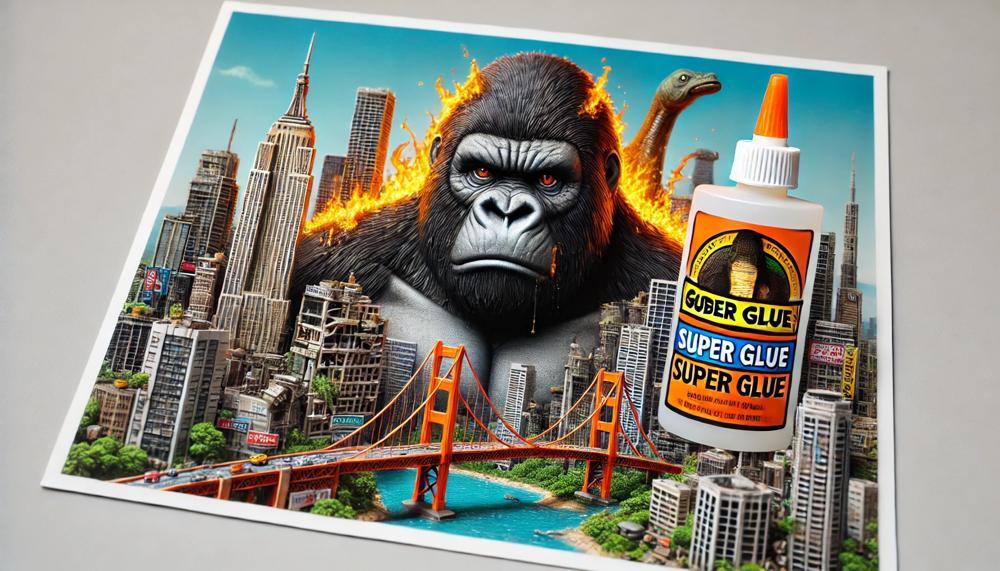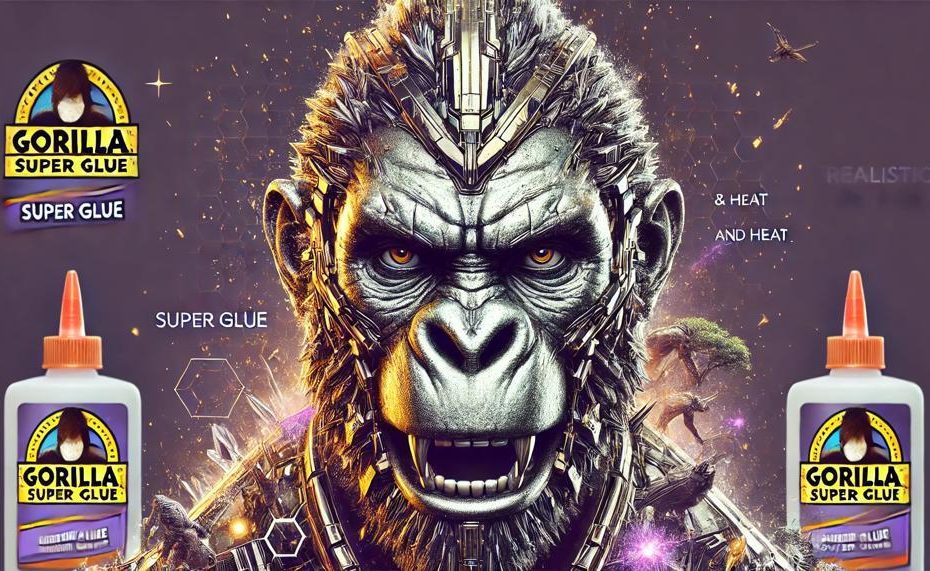Yes, Gorilla Super Glue can get hot when exposed to high temperatures. While it is designed to be resistant to various conditions, including temperature changes, extreme heat can still impact its performance.
The cyanoacrylate adhesive in Gorilla Super Glue has a melting point of around 180°F (82°C). However, it is recommended to avoid prolonged exposure to temperatures above 140°F (60°C) for optimal strength and durability.
Key takeaways:
- Gorilla Super Glue bonds strongly but can soften or melt when exposed to extreme heat.
- The melting point is 180°F (82°C), and prolonged exposure above 140°F (60°C) should be avoided.
- Specialized heat-resistant formulations like Gorilla Super Glue Gel may be better suited for high-temperature applications.
- Proper storage and handling precautions should be taken to prevent heat exposure and fume inhalation.
Understanding the heat limitations of Gorilla Super Glue is crucial for ensuring safe and effective use, especially in applications where high temperatures are involved. Failure to consider this factor could compromise the adhesive’s performance and potentially lead to safety hazards.
Table of Contents
- 1 Temperature Resistance of Gorilla Super Glue
- 2 Effects of Extreme Temperatures on Gorilla Super Glue
- 3 Manufacturer Guidelines for Using Gorilla Super Glue
- 4 Proper Ventilation and Avoiding Heat Sources
- 5 Bonding Materials and Their Temperature Tolerance
- 6 Alternative Adhesives for High-Temperature Applications
- 7 Conclusion
Temperature Resistance of Gorilla Super Glue
Here’s a direct comparison of the temperature resistance of Gorilla Super Glue to other popular adhesives:
| Adhesive | Temperature Range | Key Points |
|---|---|---|
| Gorilla Super Glue | -0°F to 99°F (-18°C to 37°C) | Performs well in cold and moderate temperatures. Starts to soften above 140°F (60°C) and melts at 180°F (82°C). |
| Standard Super Glue | 0°F to 79.6°F (-18°C to 26.5°C) | Limited temperature range compared to Gorilla Super Glue. Bonds can become brittle in cold temperatures. |
| Epoxy Adhesives | -40°F to 200°F (-40°C to 93°C) | Excellent heat resistance, but can be brittle in extreme cold. Curing time is temperature-dependent. |
| Hot Melt Glues | Up to 400°F (204°C) | Designed for high-temperature applications, but bond strength decreases as temperature drops. |
As the table illustrates, Gorilla Super Glue offers a broader temperature range than standard super glues, making it more versatile for various environments. However, epoxy and hot melt adhesives outperform it in extreme heat resistance. For cold temperatures, Gorilla Super Glue excels over regular super glues but may not match the performance of specialized epoxy formulations.
Effects of Extreme Temperatures on Gorilla Super Glue
Extreme heat adversely impacts the performance and longevity of Gorilla Super Glue bonds. When exposed to scorching temperatures, the adhesive becomes increasingly brittle and susceptible to cracking or breaking under stress. This brittleness compromises the durability and resilience of the bond, potentially leading to premature failure.
While Gorilla Super Glue boasts a wider temperature range than conventional super glues, its performance may be outmatched by specialized epoxy adhesives designed explicitly for high-heat applications.
| Extreme Heat Impact | Explanation | Recommendation |
| Increased brittleness | Heat causes the adhesive to become more rigid and less flexible, making it prone to cracking or shattering under stress. | Avoid prolonged exposure to extreme heat or consider using a specialized epoxy adhesive designed for high-temperature applications. |
| Compromised bond strength | The brittleness weakens the bond, potentially leading to premature failure or separation of the joined surfaces. | Regularly inspect bonds exposed to high heat and consider reinforcing or replacing them if necessary. |
While Gorilla Super Glue offers a wider temperature range than standard cyanoacrylate adhesives, its performance may degrade when subjected to excessive heat.
Manufacturer Guidelines for Using Gorilla Super Glue
| Guideline | Description | Importance |
| Use at room temperature | For optimal bonding, apply Gorilla Super Glue at room temperature (above 0°F/18°C). Avoid using it in extremely cold conditions. | Ensures the glue cures properly and forms a strong bond. |
| Warm cold surfaces | If the surface is cold, warm it up with a hair dryer or by placing it in a warm area before applying the glue. | Helps the glue cure and bond effectively on cold surfaces. |
| Avoid extreme heat | While Gorilla Super Glue has a wider temperature range than regular super glues, it’s best to avoid exposing cured bonds to extreme heat, as it can make them brittle and prone to cracking or breaking. | Prevents weakened or failed bonds due to excessive heat exposure. |
The manufacturer’s guidelines emphasize using Gorilla Super Glue at room temperature and warming cold surfaces before application. This ensures proper curing and strong bonding. Additionally, it’s crucial to avoid exposing cured bonds to extreme heat, as it can compromise their integrity and lead to brittleness and potential failure.
Proper Ventilation and Avoiding Heat Sources
Proper ventilation is an indispensable factor for the safe and efficacious application of Gorilla Super Glue. This adhesive, formulated with cyanoacrylate as its primary bonding agent, generates heat during its curing process. Insufficient ventilation can lead to a buildup of fumes, potentially compromising the bond strength and posing health risks.
Evading heat sources is equally paramount. Gorilla Super Glue exhibits an impressive temperature resistance range, from a frigid -65°F (-54°C) to a scorching 220°F (104°C). However, prolonged exposure to extreme temperatures, whether sweltering heat or biting cold, can enfeeble the bond over time, diminishing the adhesive’s prowess.
To harness the full potential of Gorilla Super Glue, it is advisable to store it in a cool, dry sanctuary, sheltered from direct sunlight or heat-emitting sources. Adhering to the manufacturer’s guidelines, ensuring adequate ventilation, and considering the temperature tolerance of the materials involved are pivotal in achieving optimal results with this tenacious adhesive.
Proper ventilation not only ensures a strong, lasting bond but also safeguards against the potential hazards of inhaling the fumes released during the curing process. These fumes, while not overly toxic, can cause irritation and discomfort if inhaled in concentrated amounts.
Avoiding heat sources is equally crucial. Excessive heat can accelerate the curing process, leading to a weaker bond or even causing the adhesive to become brittle and prone to failure. Conversely, extreme cold can slow down the curing process, resulting in a longer setting time and potentially compromising the bond strength.
By maintaining a moderate temperature and providing ample ventilation, users can maximize the performance of Gorilla Super Glue, ensuring a strong, durable bond that stands the test of time. Additionally, proper storage and disposal of expired or compromised glue are essential for maintaining its effectiveness and minimizing environmental impact.
In summary, proper ventilation and avoiding heat sources are critical factors in achieving optimal performance with Gorilla Super Glue. Adequate ventilation ensures a safe working environment and facilitates a strong, lasting bond, while steering clear of extreme temperatures preserves the adhesive’s integrity and longevity.
Bonding Materials and Their Temperature Tolerance
Temperature plays a pivotal role in the bonding ability and effectiveness of Gorilla Super Glue.
| Temperature Range | Bonding Ability | Remarks |
| Below 45°F (7°C) | Poor or no bonding | Curing is significantly slowed or prevented at low temperatures, resulting in weak or failed bonds. |
| 45°F (7°C) to 180°F (82°C) | Optimal bonding | This is the recommended temperature range for applying Gorilla Super Glue, ensuring proper curing and strong adhesion. |
| Above 180°F (82°C) | Bond failure | Excessive heat can cause the adhesive to degrade, leading to bond failure and potential safety hazards. |
For optimal performance, Gorilla Super Glue should be applied within the temperature range of 45°F (7°C) to 180°F (82°C). Temperatures below 45°F can significantly slow down or prevent the curing process, resulting in weak or failed bonds. On the other hand, temperatures above 180°F can cause the adhesive to degrade, leading to bond failure and potential safety hazards.
It’s worth noting that once Gorilla Super Glue has fully cured, the bond can withstand temperatures ranging from -65°F (-54°C) to 220°F (104°C) without compromising its strength or integrity. This wide temperature tolerance makes it suitable for various applications, from outdoor projects to high-heat environments.
To ensure optimal bonding and long-lasting adhesion, it’s crucial to follow the manufacturer’s instructions carefully, including temperature guidelines and surface preparation recommendations.
Alternative Adhesives for High-Temperature Applications

| Alternative Adhesives | Heat Resistance | Comparison to Gorilla Super Glue |
| Epoxy Adhesives | Up to 500°F (260°C) | Significantly higher heat resistance, ideal for industrial applications |
| Silicone Adhesives | Up to 600°F (315°C) | Excellent heat and chemical resistance, flexible bonding |
| Ceramic Adhesives | Up to 2,000°F (1,093°C) | Unparalleled heat resistance for extreme environments |
For high-temperature applications, several alternative adhesives outperform Gorilla Super Glue in terms of heat resistance. Epoxy adhesives, formulated with heat-resistant resins, can withstand temperatures up to 500°F (260°C), making them suitable for industrial settings like automotive and aerospace. High-temp epoxy adhesives provide significantly higher heat resistance than cyanoacrylate-based super glues like Gorilla.
Silicone adhesives, renowned for their flexibility and durability, can resist temperatures up to 600°F (315°C). These adhesives excel in bonding dissimilar materials and offer exceptional heat and chemical resistance, making them ideal for applications in high-temperature environments, such as automotive gaskets and sealants.
For extreme heat conditions, ceramic adhesives stand out as the most heat-resistant option, withstanding temperatures up to an astonishing 2,000°F (1,093°C).
Conclusion
While famed for its incredible bonding strength, Gorilla Super Glue does have its limits when it comes to heat resistance. Like a superhero with an Achilles heel, this mighty adhesive can lose its grip when temperatures soar too high. With a melting point of 180°F (82°C), the cyanoacrylate bonds start weakening above 140°F (60°C). Imagine a frozen waterfall slowly thawing – the once rock-solid bonds become brittle and prone to shattering under stress.
However, Gorilla doesn’t throw in the towel that easily. When properly cured, it can withstand an impressive temperature range from a frosty -65°F (-54°C) all the way up to a scorching 220°F (104°C). But subjecting it to excessive, prolonged heat is akin to leaving it too close to the sun – its powers will inevitably wane.
For high-heat applications where Gorilla may get singed, specialty adhesives like epoxies or silicones make for more heat-resistant sidekicks. Yet for most everyday tasks within its temperature sweet spot, this tenacious glue remains a trusty superhero ready to form bonds stronger than steel itself.






